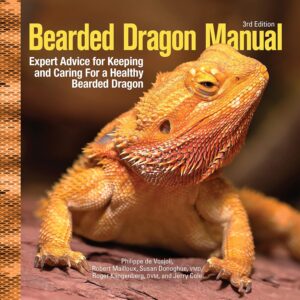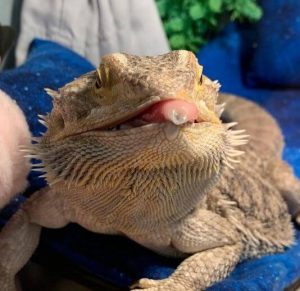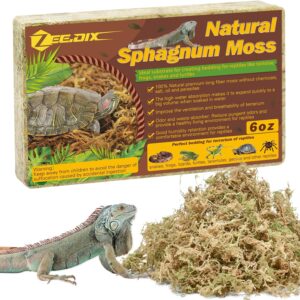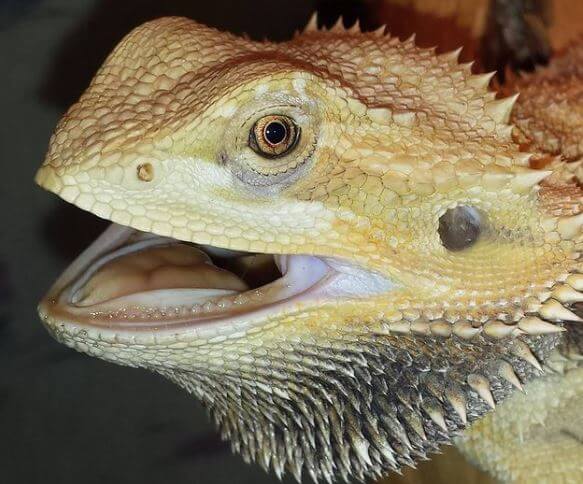What Does It Mean When A Bearded Dragon Licks You
What does it mean when a bearded dragon licks you: Bearded dragons (Pogona vitticeps) have become increasingly popular as pets due to their unique appearance and captivating personalities. With their enchanting beards and gentle disposition, these reptiles have won the hearts of many reptile enthusiasts.
However, despite their growing popularity, there is still much to learn about their behavior and communication with humans. One intriguing question that often arises among bearded dragon owners is: What does it mean when a bearded dragon licks you?
Brief Overview of Bearded Dragons as Pets
 Bearded dragons are native to Australia and are commonly found in arid regions such as deserts and woodlands. As pets, they require specific care to ensure their health and well-being.
Bearded dragons are native to Australia and are commonly found in arid regions such as deserts and woodlands. As pets, they require specific care to ensure their health and well-being.
These reptiles thrive in enclosures that mimic their natural habitat, complete with basking spots for warmth, UVB lighting for proper calcium metabolism, and a varied diet consisting of insects, leafy greens, and occasional fruits. Bearded dragons have distinct physical characteristics that set them apart from other reptiles.
They possess rough skin covered in small scales that create the appearance of a beard when puffed out during displays of aggression or courtship rituals. Their ability to change color based on temperature or mood makes them even more fascinating.
Intriguing Question: What Does It Mean When a Bearded Dragon Licks You?
The act of licking by bearded dragons often perplexes owners who are unfamiliar with this behavior. Licking can vary in intensity – from gentle flicks with the tongue to more prolonged contact with human skin – leaving pet owners wondering about its significance.
To understand the meaning behind this behavior, it is crucial to delve into the realm of bearded dragon communication and decipher the potential reasons behind their licking tendencies. By examining various factors such as trust-building behaviors, taste sensitivity in reptiles, and how bearded dragons perceive human skin, we can shed light on the intriguing question of what it means when a bearded dragon licks you.
In the following sections, we will explore these topics in detail to unravel the fascinating world of bearded dragon behavior and provide insights into this unique form of communication between these reptiles and their human companions. By doing so, we hope to offer a deeper understanding of the bond that can be formed with these captivating creatures and highlight the significance of their licking behavior.

Description of Bearded Dragons as Reptiles
Bearded dragons, scientifically known as Pogona, are a species of reptile native to the arid regions of Australia. They belong to the family Agamidae and are widely popular as pets due to their docile nature and unique appearance. These fascinating creatures have distinct characteristics that set them apart from other reptiles.
Physically, bearded dragons possess a stout body with a triangular head and sharp claws. Their most distinctive feature is the spiny beard-like projection under their chin, which they can puff up when feeling threatened or displaying territorial behavior.
They have rough, scaly skin that helps protect them from harsh environments and predators. With an average length ranging from 12 to 24 inches (30-60 cm), bearded dragons exhibit sexual dimorphism.
Adult males tend to be larger and more robust than females with more pronounced spikes on their bodies. Furthermore, they display vibrant color patterns ranging from earthy browns and greens to striking oranges and reds.
Overview of Their Behavior and Communication Methods
 Bearded dragons showcase a wide range of behaviors that reflect their unique personalities. They are diurnal creatures, meaning they are active during the day.
Bearded dragons showcase a wide range of behaviors that reflect their unique personalities. They are diurnal creatures, meaning they are active during the day.
This is advantageous for pet owners as it allows for more interactive bonding opportunities. In terms of communication methods, bearded dragons employ various mechanisms to convey messages or establish dominance within their social hierarchy.
One common behavior is head bobbing, where males rhythmically move their heads up and down in an attempt to assert dominance or attract mates. Additionally, bearded dragons communicate through visual cues such as posture changes or coloration alterations on specific body parts like their throat or tails.
For instance, when a beardie darkens its beard (beard blackening), it may indicate aggression, stress, or illness. Conversely, a lighter colored beard may signify relaxation or contentment.
Furthermore, bearded dragons are known for their gentle nature and curious disposition. They often exhibit exploratory behavior by actively investigating their surroundings using tongue flicking and smelling with their highly sensitive Jacobsen’s organs located on the roof of their mouths.
Licking Behavior in Bearded Dragons
General observation: Bearded dragons occasionally lick their owners
One intriguing behavior that bearded dragon owners often encounter is their pet licking them. While not all bearded dragons engage in this behavior, it is not uncommon for them to show an interest in licking their owners.
This behavior can be observed during moments of interaction, such as when handling or playing with the reptile. Although it may seem unusual for a reptile to exhibit such behavior, understanding the possible reasons behind it can shed light on the fascinating world of bearded dragon communication.
Possible reasons behind this behavior
 There are several potential explanations for why a bearded dragon may engage in licking behaviors towards their owners. One possibility is that they are exploring their environment through taste and touch.
There are several potential explanations for why a bearded dragon may engage in licking behaviors towards their owners. One possibility is that they are exploring their environment through taste and touch.
Like many reptiles, bearded dragons use their tongues to gather information about objects and surfaces within their surroundings. By flicking and occasionally licking various surfaces, including human skin, they can gain a better understanding of unfamiliar elements present in their environment.
Another reason behind this behavior could be related to scent detection and identification. Bearded dragons have a highly developed sense of smell, aided by specialized organs called Jacobson’s organs located on the roof of their mouths.
These organs allow them to detect chemical signals emitted by other animals or objects. Licking serves as a means for transferring these scent molecules onto these sensory organs, helping the beardies better understand and identify scents they encounter.
Furthermore, it is important to consider that beardies engage in social bonding with their human caretakers over time. As trust and affection develop between a bearded dragon and its owner through gentle handling, feeding routines, and positive interactions, licking can become part of their bonding repertoire.
It may serve as a sign of trust from the bearded dragon towards its owner while also reinforcing the emotional connection between them. While not all bearded dragons exhibit licking behavior towards their owners, it is a fascinating aspect of their communication and bonding mechanisms.
By licking, they can explore their environment, gather information through scent detection, and potentially express trust and affection towards their human caretakers. Understanding these reasons behind the behavior can help deepen the bond between owners and their scaly companions while unraveling the intricacies of bearded dragon communication.
Communication and Bonding
Licking as a Form of Communication between Bearded Dragons
Within the captivating realm of bearded dragons, communication takes on various intriguing forms. While these incredible reptiles lack the capacity for verbal language, they have developed unique methods to convey messages.
One such method is through their exceptional ability to lick, which plays a significant role in their communication repertoire. By observing their behavior closely, we can decipher the subtle meanings behind their licks.
Exploring the Environment through Tongue Flicking and Licking Objects
Tongue flicking and object licking serve as integral components of a bearded dragon’s exploration process. Through these actions, they gain valuable sensory information about their surroundings, enhancing their understanding of the environment they inhabit.
Delicately flicking their tongues in quick succession allows them to detect and analyze airborne particles that carry scents, providing vital clues about nearby objects or creatures. When a bearded dragon encounters an unfamiliar object or surface within its habitat, it will often extend its tongue to investigate further.
As it touches the object or surface with its moist tongue, sensory receptors located in specialized pits on their tongues transmit valuable information back to them. This intricate feedback mechanism aids in determining the texture, temperature, and even taste of objects present in their surroundings.
Scent Detection and Identification through Licking
For bearded dragons, scent detection is an essential survival skill that helps them identify potential threats or sources of sustenance. Akin to snakes and other reptiles with a keen sense of smell, bearded dragons possess a highly developed organ called the Jacobson’s organ situated near the roof of their mouths.
When encountering new scents emitted by objects or living beings around them – including humans – bearded dragons may engage in licking behaviors as part of scent identification. By licking an object or even their owners, they absorb minute particles that carry distinct scents.
These particles are then transferred to the Jacobson’s organ, enabling the bearded dragon to analyze and categorize the scents accurately. Through their sophisticated communication methods, including tongue flicking and object licking, bearded dragons establish a deeper connection with their environment.
This unique form of communication allows them to explore and understand their surroundings while also facilitating scent detection and identification. By comprehending these fascinating behaviors, we gain valuable insight into the intricate world of these captivating reptiles.
Trust and Affection towards Owners
Licking as a sign of trust between a bearded dragon and its owner
What does it mean when a bearded dragon licks you? When a bearded dragon engages in the act of licking its owner, it can often be interpreted as a display of trust and affection. This behavior signifies that the reptile has developed a bond with its human counterpart, understanding that they pose no harm. Trust is essential in any relationship, including the one between a pet reptile and its owner.
Licking is considered one of the ways these creatures express their trust and comfort towards humans. Bearded dragons are known to be social animals, capable of forming strong bonds with their owners over time.
Through regular interaction, feeding routines, and gentle handling, these reptiles become accustomed to their owners’ presence. As trust builds gradually, the bearded dragon starts demonstrating behaviors like licking as an indication of their confidence in the owner’s ability to provide for them.
Explanation of how trust is built over time
Developing trust between a bearded dragon and its owner requires patience and consistency. Initially, when introduced to their new environment and caretaker, these reptiles may exhibit signs of shyness or skittishness.
Owners must allow their bearded dragons ample time to acclimate to their surroundings without forcing any interactions or handling. As the reptile becomes more familiar with its environment and caregiver, it begins associating positive experiences with human presence.
Regular feeding sessions where the owner hand-feeds specific treats or food items can help strengthen this bond further. Over time, gentle handling techniques that respect the lizard’s boundaries will aid in building mutual trust.
Comparison to other reptile behaviors indicating trust: What does it mean when a bearded dragon licks you?
While licking is one notable behavior that signifies trust between bearded dragons and humans specifically, there are other actions observed in various reptiles that also indicate similar levels of trust. For example, some reptiles may exhibit a relaxed body posture, such as lying flat and extended limbs when being handled or approached by their owner. This posture indicates that the reptile feels calm and secure in the presence of its owner.
In addition to physical behaviors, vocalizations can also convey trust. Some reptiles, including certain types of geckos or turtles, make soft chirping or purring sounds when they are comfortable and content with their human companion.
These sounds are regarded as positive vocalizations that mirror the actions of licking or relaxed body postures in bearded dragons. Licking is a visible representation of trust and affection between bearded dragons and their owners.
Trust is built over time through regular positive interactions, gentle handling techniques, and an understanding of the lizard’s boundaries. While licking is not exclusive to bearded dragons and can vary among reptile species, it remains a prominent behavior that reflects the bond formed between these majestic creatures and their human caregivers.
Taste Sensitivity in Bearded Dragons
In-depth exploration of the taste receptors in bearded dragons’ mouths
Bearded dragons, like many other creatures, possess a remarkable sense of taste that aids them in identifying and selecting suitable food sources. Within their mouths, they harbor a variety of taste receptors that allow them to perceive different flavors.
These receptors are found on the surface of their tongues and palates, where they come into contact with food particles during feeding. The intricate network of taste buds consists of specialized cells that respond to specific chemical compounds present in food, enabling the bearded dragon to discern various tastes.
Their ability to differentiate tastes, including saltiness and sweetness
Studies have revealed that bearded dragons can differentiate between different tastes, including saltiness and sweetness. Their taste buds are particularly sensitive to salts due to the presence of sodium channels within their receptor cells. This heightened sensitivity allows them to detect even trace amounts of salt in their environment or on objects they encounter.
As for sweetness, while bearded dragons may not possess as robust a sweet tooth as humans do, their taste receptors can still detect certain sugars present in fruits or nectar. Interestingly, bearded dragons have shown an increased preference for foods with high protein content rather than those with higher sugar levels.
This aligns with their natural diet in the wild which mainly includes insects and small vertebrates. However, it is important to note that individual preferences may vary among bearded dragons.
Impact on their feeding habits
The taste sensitivity exhibited by these reptiles plays a vital role in shaping their feeding habits. For instance, when presented with multiple food options containing different flavors or scents, bearded dragons rely heavily on their taste receptors to make dietary choices. Their ability to distinguish between desirable and potentially harmful substances through taste also contributes significantly to their survival.
Bearded dragons possess a strong aversion to bitter tastes, which helps them avoid toxic or noxious plants that may be harmful when consumed. This innate ability to detect bitterness acts as a natural defense mechanism, steering them away from potentially dangerous food sources.
The taste sensitivity of bearded dragons is a fascinating aspect of their sensory capabilities. Their tongue and palate are adorned with intricate taste receptors that allow them to differentiate between various flavors, including saltiness and sweetness.
These receptors influence their feeding habits, helping them make informed dietary choices and avoiding potentially harmful substances. Understanding the intricacies of their taste perception provides valuable insights into the behaviors and preferences of these captivating reptilian companions.
Interaction with Human Skin
Explanation of why bearded dragons may find human skin intriguing
Bearded dragons possess a keen sense of curiosity and are naturally inclined to explore their surroundings. Human skin, with its unique texture, scent, and warmth, can captivate the curiosity of these reptiles. The smoothness and softness of human skin might differ significantly from the rough textures they encounter in their natural habitat.
This contrast could pique their interest and drive them to investigate further. Moreover, the warmth emitted by human skin might attract bearded dragons as they seek out sources of heat to thermoregulate.
What does it mean when a bearded dragon licks you? Possible reasons for licking human skin
One plausible explanation for a bearded dragon licking human skin is the presence of salt residue left by sweat on the surface. Humans naturally excrete small amounts of salt through perspiration, which can create an intriguing sensory experience for bearded dragons.
Salt serves as an essential mineral in their diet, and by licking salty areas on our skin, they may attempt to supplement their sodium intake. Furthermore, bearded dragons are highly perceptive creatures; they learn to associate positive experiences with certain stimuli.
For instance, if a bearded dragon receives food or affection from its owner while sitting on their hand or arm, it may associate that area with pleasant experiences. Consequently, when given the opportunity to interact with exposed human skin again in the future, they may instinctively lick it as a means of expressing trust or seeking similar positive encounters.
It is important to note that while these explanations provide insight into why bearded dragons might exhibit such behavior towards human skin, individual reptiles’ motivations may vary due to factors such as socialization history and personal preferences. Therefore, observing your own beardie’s behavior patterns can help you better understand their specific inclinations towards interacting with your skin.
Remember that each bearded dragon has its unique personality and may display different preferences or behaviors. Building a strong bond with your pet through regular handling and positive reinforcement can further enhance their trust in you and promote a harmonious relationship between you and your scaly companion.
Health Considerations
Addressing concerns about hygiene and safety when being licked by a bearded dragon
When it comes to interacting with a bearded dragon, hygiene and safety are important considerations. While it may seem harmless for them to lick you, there are a few factors to keep in mind. Firstly, ensure that your hands are clean before handling your pet.
Washing your hands with mild soap and warm water helps minimize the risk of transferring any potential harmful bacteria or substances from your skin onto the reptile. Additionally, avoiding wearing any strong-smelling lotions or creams can prevent confusion or potential negative reactions from the bearded dragon.
It is worth noting that bearded dragons naturally carry some bacteria in their mouths as part of their oral flora. While it’s generally not an issue, individuals with compromised immune systems should take extra precautions when handling these pets.
If you have any open wounds or sores on your skin, it is advisable to avoid direct contact between those areas and the reptile’s saliva. Furthermore, maintaining proper cleanliness in their enclosure, including regular cleaning of their water dish and habitat, helps reduce the chances of bacterial growth that might pose a risk to both you and your pet.
To sum up: What Does It Mean When a Bearded Dragon Licks You?
Understanding what it means when a bearded dragon licks you involves delving into their communication methods and underlying motivations. While licking can serve as a form of bonding and trust-building between the reptile and its owner, there are also practical considerations regarding hygiene and safety that need to be addressed. By being mindful of hygiene practices before interacting with your pet bearded dragon—such as washing your hands thoroughly—and ensuring that their enclosure remains clean, you can foster a safe environment for both yourself and your scaly companion.
So next time your bearded dragon extends its tongue toward you for a little lick, remember that it could be their way of expressing trust and affection. Embrace this unique form of communication, and make it a part of your bond with these remarkable reptiles.
Further Reading:
- Carolina Custom Cages Terrarium Review
- 8 Best Basking Rocks for Beardie: What Is the Best Choice?
- 10 Best Thermometers for Beardie: How to Choose the Best One?
- 5 Best Beardie Lighting Setups for Beardie Lovers
- 9 Best Heat Lamps for Beardie: Natural Habitat Provided


